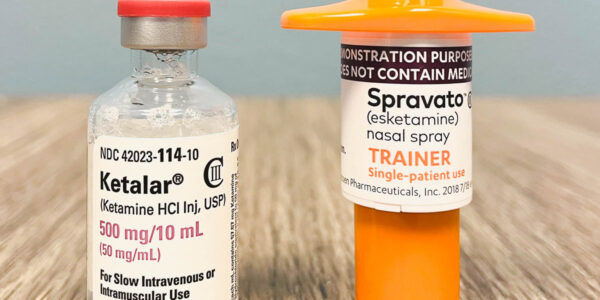LISTEN TO THIS ARTICLE:
To people who are suffering, suicide all too frequently can seem like a way to escape. Hopelessness is itself a symptom of depression so this kind of thinking comes from clouded judgment. In a depressed state it is difficult if not impossible for the person to comprehend and believe that things can get better. It is imperative that they are kept safe long enough for such thoughts to subside. Unfortunately, suicide in America has been rising for years.
The Numbers
A top 10 killer
Every 13 minutes, someone dies of suicide in America. According to the most recent assessment, we lost close to 45,000 Americans to suicide in 2016. This is a 25% increase in less than 20 years, and the highest rate in 30 years. Overall, it is the 10th most common cause of death in the United States, but in younger age groups, it jumps up to the 3rd most common cause.
Dark thoughts, dangerous plans
Although tens of thousands perish by suicide, millions more contemplate it. Well over 8 million Americans seriously consider suicide each year, and at least a quarter of those, 2 million, develop a specific plan about how they would do it. In turn, half of those who make a plan, about 1 million, will follow through and attempt to take their own lives. This means that for every completed suicide each year, there are 25 other people who tried to take their own lives but survived.
Gender paradox
Women are about 3 times more likely to attempt to take their own lives than men, but men are 3½ times more likely to die by suicide. Men make up more than three quarters of all deaths from suicide. This is because men tend to use more lethal methods than women.
Causes and risk factors
Past Behavior Predicts Future Behavior
One of the most significant risk factors for future suicide attempts is a history of having tried in the past. People who have tried before are 30-40 times more likely than average to try again.
Depression and other mental illnesses
Depression is present in half of all suicides, and is the most commonly associated mental health condition. What’s more, up to 15% of people with untreated depression are likely to die by suicide. However, depression is not alone as a culprit. Bipolar Disorder, Schizophrenia, Substance Use Disorders, and Anxiety Disorders all put people at increased risk for suicide. Co-occurring disorders, depression and alcohol use together for example, are particularly dangerous.
Ramped up stress
For people who are already at risk, an increase in life stressors can be the catalyst that moves them to action. These might be sudden changes like the end of a major relationship, job loss, or financial ruin. They could also be problems that build over time, such as ongoing harassment or an abusive relationship.
Impulsivity
Although people can harbor suicidal thoughts for extended periods, planning and taking deadly action often happens in a very short period of time. Studies of people who tried to take their own lives but survived reveal that between half and two-thirds of them took less than a half hour to plan and then attempt suicide.
The gun question
People who have thoughts about suicide and who also own firearms are at higher risk for dying by suicide. However, that is not to say that guns owners are more prone to suicidal thoughts or behavior. The risk only lies in having access to such a lethal method,
Guarding against it
Warning signs
The most blatant warning signs that someone is at risk are: talking about death, expressing a wish to die, and researching possible methods (as one might find in their internet browser history). Other signs include people talking about how they feel trapped, feel like a burden, that others would be better off without them, that they don’t feel like they belong, like their life is hopeless, that they are suffering and see no way out.
People who are planning to take their own lives may prepare by giving away possessions, preparing a will, writing letters to loved ones, or saying goodbyes to close friends and family. They may withdraw from other areas of their lives, like school or work. Self-care can take a drastic dive as well, and people may stop putting energy into their appearance. They eat less, forego sleep, and may use drugs or alcohol.
A wall of denial
Depressed people might downplay the severity of what they are going through, not wanting to burden others, or thinking there is nothing that will help anyway. However, anyone who has gotten to the point where they are talking about death or seeing it as a possible solution to their problems cannot be expected to manage by themselves. People are often embarrassed by their situation and want to keep it secret. This may especially be the case with a celebrity or someone in the public eye. This is a carryover from the past, when mental illness was viewed more widely as a weakness of will. While our culture has made great strides in understanding and treating mental health conditions, stigma continues to be a barrier and too many people still needlessly suffer instead of getting help.
What to do
Being a friend or family member of someone who is considering suicide can be incredibly difficult. No two situations are exactly alike, and the pressure and stress can seem overwhelming. If you or someone you know is contemplating death, or you suspect that someone might be, remember that you are not alone. The National Suicide Prevention Lifeline, 1-800-273-8255, is staffed 24/7 and offers free, confidential support and resources. It is nearly impossible to know how serious someone’s intentions are based on their behaviors, so it is best to err on the side of caution. If you feel that someone’s life is in imminent danger, call 911 and enlist the services of the nearest hospital emergency department. They are best equipped to handle these situations. Remember, the goal is to keep the person safe until the thoughts and feelings resolve.
When the worst happens and we lose someone to suicide, a torrent of guilt, anger, regret, and sorrow wash over us. It can feel like a devastating wave as we are consumed by thoughts of what we could have or should have done. Everyone deals differently, but we deal best together. Reach out to those around you: friends, family, coworkers, therapists, and support groups. We survive by supporting each other. If you believe that your own grief or angst over such a loss has reached a level beyond what is manageable, don’t hesitate to reach out for help yourself.


 Learn
Learn Read Stories
Read Stories Get News
Get News Find Help
Find Help
 Share
Share
 Share
Share
 Share
Share
 Share
Share



